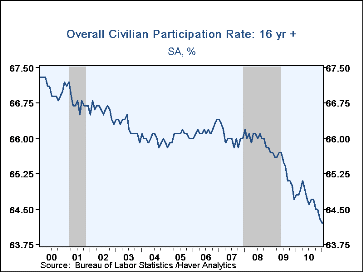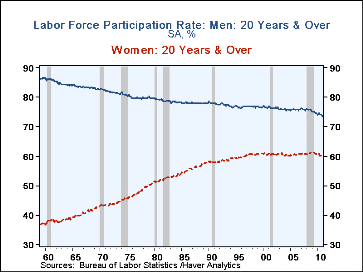 Global| Feb 18 2011
Global| Feb 18 2011U.S. Labor Force Participation Falls
by:Tom Moeller
|in:Economy in Brief
Summary
The slack job market has caused participation in the labor force to fall to its lowest since 1984. Last year, of the eligible population of 237.8 million, the participation rate fell to 64.7%. Of the 85.5 million who weren't in the [...]
 The slack job market has caused participation in the labor
force to fall to its lowest since 1984. Last year, of the eligible population of
237.8 million, the participation rate fell to 64.7%. Of the 85.5 million who
weren't in the labor force as recently as last month, 6.6 million want a job
now, the highest since 1994 when this figure was first tallied and up from 4.7
million in 2007. The job market is so poor that 1.173 million wanted a job but
were discouraged from looking for one, up from 262,000 in 2000. Were these individuals in the
labor force and unemployed, the unemployment rate would have been closer to 11%
instead of the official 9.6%.
The slack job market has caused participation in the labor
force to fall to its lowest since 1984. Last year, of the eligible population of
237.8 million, the participation rate fell to 64.7%. Of the 85.5 million who
weren't in the labor force as recently as last month, 6.6 million want a job
now, the highest since 1994 when this figure was first tallied and up from 4.7
million in 2007. The job market is so poor that 1.173 million wanted a job but
were discouraged from looking for one, up from 262,000 in 2000. Were these individuals in the
labor force and unemployed, the unemployment rate would have been closer to 11%
instead of the official 9.6%.
The detailed data indicate that participation in the labor force is down sharply by age and sex, most notably for young males. For these individuals the rate fell to 35.2% last month from its high over 60.0% in the early 1980s. For teenage women the rate also was down to 34.0% from its high of 54.0% in the 1989. For the adult population, the downward direction is the same. For adult men, the labor force participation rate fell to 73.2% last month from its high just under 90% just after WWII. For adult women, their determination to stay in the labor force has been stronger and the rate just slipped to 60.0% from its high of 60.9% in 2008.
Data on participation rates can be found in Haver's USECON and EMPLR databases.
| Labor Force Participation | January | December | 2010 | 2009 | 2008 |
|---|---|---|---|---|---|
| Labor Force Participation Rate - Overall | 64.2% | 64.3% | 64.7% | 65.4% | 66.0% |
| Males - 20 years and over | 73.2 | 73.6 | 74.1 | 74.8 | 75.7 |
| Males - 16 to 19 | 35.2 | 34.5 | 34.9 | 37.3 | 40.1 |
| Women - 20 years and over | 60.0 | 60.1 | 60.4 | 60.8 | 60.9 |
| Women 16 to 19 | 34.0 | 34.1 | 35.0 | 37.6 | 40.2 |
| Not in Labor Force | 86.2M | 85.7M | 83.9M | 81.7M | 79.5M |
| Persons Who Currently Want a Job | 6.6 | 6.2 | 6.1 | 5.9 | 5.0 |
Tom Moeller
AuthorMore in Author Profile »Prior to joining Haver Analytics in 2000, Mr. Moeller worked as the Economist at Chancellor Capital Management from 1985 to 1999. There, he developed comprehensive economic forecasts and interpreted economic data for equity and fixed income portfolio managers. Also at Chancellor, Mr. Moeller worked as an equity analyst and was responsible for researching and rating companies in the economically sensitive automobile and housing industries for investment in Chancellor’s equity portfolio. Prior to joining Chancellor, Mr. Moeller was an Economist at Citibank from 1979 to 1984. He also analyzed pricing behavior in the metals industry for the Council on Wage and Price Stability in Washington, D.C. In 1999, Mr. Moeller received the award for most accurate forecast from the Forecasters' Club of New York. From 1990 to 1992 he was President of the New York Association for Business Economists. Mr. Moeller earned an M.B.A. in Finance from Fordham University, where he graduated in 1987. He holds a Bachelor of Arts in Economics from George Washington University.








